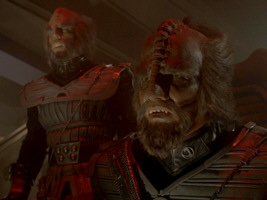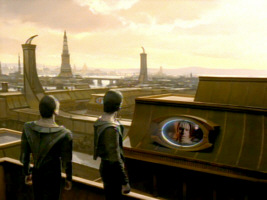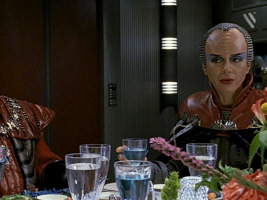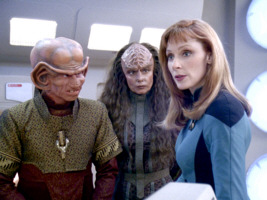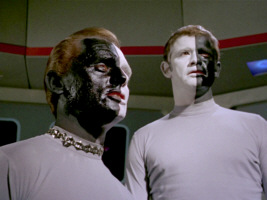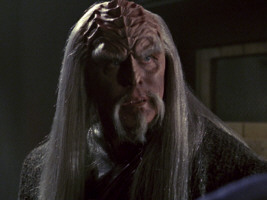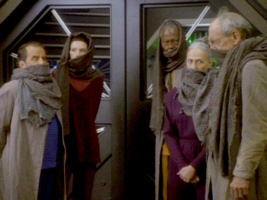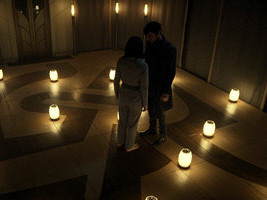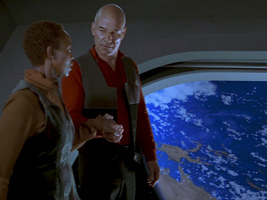Alien Monocultures in Star Trek
This is not an article about agriculture! The actual subject is the depiction of alien civilizations in Star Trek, which have been criticized as being generally monolithic entities. Alien cultures appear to lack the racial, linguistic, cultural, religious and social diversity as it can be expected even under an authoritative political system. Individual alien characters are said to be stereotypical representatives of their culture, with too few exceptions.
Critics of the franchise habitually bring forward the issue, especially if their goal is to demonstrate that there must be a hidden political agenda behind Star Trek, one that promotes conformism or intolerance. It may not be feasible to find evidence that would ultimately disprove the assertion of Star Trek being one-sided in the portrayal of aliens, and it would go beyond the scope of this article to scrutinize each and every occurrence of a racial or cultural cliché or its avoidance. But the following considerations, made from a more general point-of-view, may shed some new light on the issue.
Discussion
The problem
This investigation puts special emphasis on the most frequently featured alien species as the ones we (believe to) know most about, with the obvious exception of the Borg as an unparalleled case of extreme uniformity. Every notable alien civilization appears to have gradually settled to a common language, a common religion or equivalent atheist philosophy, a common fashion and a common way of life, and not necessarily always by force. Even if it seems like an insignificant observation, all Romulans of the mid-24th century have the same haircut and the architectural style on any alien planet is usually much more uniform than it was in any era of Earth's history. Seemingly every Klingon seeks to be a warrior, every Vulcan strives to pursue the study of logic, every Ferengi has no other goal than to accumulate wealth, with very few exceptions that are explicitly said to be very uncommon. Exceptions such as Rom as a male Ferengi who is not at all dominated by greed only seem to prove the rule.
Moreover, we have seen several alien cultures in which mere dissent or being different, not even active opposition, was considered a sufficient reason for ostracism or banishment. The "melders" got excluded from the Vulcan society of the 22nd century, and non-neuters among the J'naii were even subject to re-education in TNG: "The Outcast". We can only speculate what would happen to a Klingon who decided to oppose his people's apparent agenda of eternal war and conquest.
Statistical considerations
How statistically significant is the widespread impression that alien races present themselves as monolithic entities? We should take into account that in any episode dealing with one certain alien species we only see a few individuals out of millions or even billions of their kind. It may be true that the "ordinary" people on the streets (such as the Klingons in TNG: "Sins of the Father", the Romulans in TNG: "Unification" or the Cardassians in a couple of DS9 episodes) are a conformist bunch, and that the same actors, dressed as humans, would look a lot more diverse.But aside from only occasional passers-by, most aliens that we perceive are either military personnel, civilian starship crews or scientists. While these groups do not have to be the elite of their race, it is clear that they can hardly be representative of their compatriots down on the respective homeworld. These "space aliens" can be expected to wear uniforms or other utility garments, but it also is not surprising if they share certain views and certain patterns of behavior.
On the other hand, this is still no reason why the general conduct of Klingon warriors, their interests and desires should be all the same. There is not really anyone in the Klingon military like Worf, who is a Klingon with an individual lifestyle and who occasionally questions his people's practices and traditions. He remains an exception, probably also because as a Starfleet officer he is allowed, even encouraged to go his own way at least in private matters. Could we imagine any other Klingon to build model ships? While there are countless episodes involving Klingons, rather few look at their culture from a Klingon perspective anyway. DS9: "Soldiers of the Empire", for instance, sheds a different light on the warriors aboard the Rotarran as a disillusioned bunch. Still, all of them engage in violence and get drunk just like Klingons on other occasions.Usually only the capital or one particular place on an alien planet is in the focus of interest in an episode or story arc. So while the Klingon capital looks like a polluted city from Earth's early industrial age, there may be pleasant places with half-way tidy residences on Qo'noS too, just as well as recreation areas. Only because the starship crew normally would not visit such places that are irrelevant for their mission, it does not mean that they do not exist. And even if it is somewhat pleasant in certain regions of Qon'oS, there may be still many reasons to prefer Risa to go on vacation.
Each alien culture seems to have settled on just one language. But do we really know that for sure? The only alien language that was ever developed far enough to be identifiable as being consistently used was tlhIngan Hol ("Klingonese") by Marc Okrand. And most of the time we heard Klingon as a military command language or in political debates. It is well possible that even the Klingon Empire is multilingual, only that we have to go to provinces far away from the capital or to other planets to hear something other than tlhIngan Hol. The existence of the preliminary Klingon language that was conceived by James Doohan for "Star Trek: The Motion Picture" before Okrand's work, as well as the writers' and actors' frequent mistakes with grammar and pronunciation of the official language may serve as evidence that not all Klingons share the same native language. Maybe this was even the reason why Uhura's awkward attempt to speak Klingon in "Star Trek: The Undiscovered Country" did not raise any suspicion.All other alien languages of Star Trek show up so infrequently and incompletely that it would be a stretch to jump to the conclusion that the planets or cultures have just one language. And isn't it that every human seems to speak English all the time by the 24th century? If this is not so outside Starfleet because of the availability of universal translators, languages just have to be equally diverse in advanced alien cultures.
Historical and political comparison
One important point to consider is that most alien governments, including the Ferengi, Cardassian, Bajoran, Klingon and Romulan political systems, are rather authoritative than democratic by present-day human standards. Most of them have clear tendencies of being oligarchic and prone to corruption. Such a system would naturally favor conformance over pluralism and may eventually wind up as a monoculture, even across multiple planets.
However, our own human history is full of examples of great empires that appear to us as monolithic today, although they most likely were not. The Roman Empire, the Spanish colonial empire, the Soviet Union, they all certainly did have a certain degree of diversity. But as seen from outside and in retrospect, all Roman cities were built after the same basic pattern (much like Cardassian style is the same on every planet or station), the Spaniards who went to South America mostly did it because of the gold (much like the Ferengi) and communist conformism ruled in the Soviet Union (much like in the Cardassian and Romulan Empires).Notwithstanding its possible truth, it may be racist to label the Klingons as a "warrior race", as it attributes identical individual characteristics to a whole species. It may be factually flawed as well because realistically not every Klingon can be a warrior, probably not even every second Klingon. In essence, it is the same as the casual statement that "The Soviets/Russians are communists", as it was commonplace during the Cold War. Interestingly, while "the Soviets" never existed as an ethnographic entity, the people of the Soviet Union were commonly identified as such, thus complying with the wish of the communist potentates. Their goal was to get away with or at least obscure the multicultural nature of their country of Russians, Ukrainians, Jews, Muslims, etc. Alternatively, "Soviets" were often simply equated with Russians, leading to much the same result that the still existing diversity inside the Soviet empire was not recognized. (To many people it came as a huge surprise when the single parts of the Soviet Union separated after the end of the communist rule.) The same considerations may apply to the concept the Federation has of the Klingon Empire. And the apparent centralism with episodes repeatedly focusing on the Klingon capital (which ironically has remained nameless) would comply with the impression that there was no news and hence not much perceptible life in the Soviet Union outside Moscow, let alone in restricted areas.
More evidence can be found in the way that aliens look upon the United Federation of Planets. Humans are the most influential race of the Federation, especially since 90% of all Starfleet personnel are human. This readily explains Azetbur's angry statement of the Federation being a "homo sapiens-only club" in "Star Trek: The Undiscovered Country", although we know or think to know that there is actually more diversity. There is no reason why Azetbur's preconception should be all wrong, but Kirk's stance on Klingons has to be true.Ironically, while many episodes deal with political intrigues, in which the nature of an alien government system naturally ought to play a decisive role, we rarely learn more about any of them. And while the Federation, as the embodiment of Roddenberry's vision of a better future, apparently has everything that a democracy needs, the events in DS9's double feature "Homefront" and "Paradise Lost" and especially in "Star Trek: Insurrection" and Star Trek Picard's first season (let alone Discovery) demonstrate that it is still susceptible to essentially the same mistakes as in authoritative regimes such as the Romulan Empire in DS9: "Inter Arma Enim Silent Leges" and "Star Trek Nemesis". Anyway, the bottom line is that Star Trek overall provides a surprisingly reasonable picture of interstellar politics, if we take into account that the perception of the other side may be flawed, up to a degree where the adversaries are reduced to clichés.
Practical and narrative considerations
A considerable amount of work goes into the concept of each new alien civilization, even if it is just a "race-of-the-week", or into any further development. The writer ideally comes up with a sketchy history and some cultural and social peculiarities, while the Star Trek Art Department strives to create a distinctive look and style of that species. Sometimes either the budget or the time was not sufficient, and the species ended up as a clone of humanity or of a prominent Trek race. While working out single characteristics is already hard enough, it would probably be a stretch to depict an alien planet-of-the-week as multicultural, not only because of time and budget constraints, but also as it may distract from the story. Even though there is generally no reason to dumb down a plot idea in order to make it more lucid, Star Trek needs consistent concepts to tell a story in just 45 minutes. Like every type of fiction, it may benefit from metaphoric and hence somewhat exaggerated portrayals. This, in addition to the mere statistical consideration that the time to show diverse alien individuals and places is limited, is the ultimate reason why we do not see many alien worlds with cultural variety.
In the cases where one-time civilizations were explicitly shown as diverse, it was either a part of the plot that a planet was divided (such as in TNG: "Attached" or ENT: "Dear Doctor"), or it took place on a generic multicultural trade outpost (such as in VOY: "Tsunkatse" or "Survival Instinct").
Pertaining to the major alien races, however, it would be desirable if the writers did not frequently resort to cookie-cutter characters like "the greedy Ferengi", "the blood-thirsty Klingon" or "the sinister Cardassian" that allow little variation - and are a perfect ground for typecasting too. Some of the rather few Klingons who are no warriors, such as the scientist Kurak in TNG: "Suspicions", not to forget B'Elanna, exhibit violent tendencies or perform their jobs like they are in a battle. For the writers working with such stereotypes and hence with expectations is certainly convenient, but at some point it may obstruct the further development of a single character or even a whole race. The undeniable profundity of the Klingons or the Vulcans as the most prominent cultures may be a predominantly statistical outcome of many hours of screen time, rather than of a concept to make them appear realistically diverse. Still, Star Trek usually excels whenever an alien race reappears, displaying a new facet of its culture.Alas, even the budget for the more prominent races is limited, and this is why we always see them with the same props and costumes. However, it is also quite convenient from the position of storytelling that certain sets, weapons, other devices, garments, written language, as well as customs and other cultural aspects can be quickly identified as Klingon and do not need to be explained each time they appear. Also, while re-using the same props for always different races is a minor nuisance, it is very efficient and cost-saving if all aliens of one species wear the same kind of costumes and possess the same kind of devices.
One reason why most alien governments are corrupt and most alien law systems are unjust is immediately obvious. A perfectly working democratic system with almost unlimited personal freedom would not allow for the generic "political intrigue" plot, which is as popular in Star Trek as in most science fiction shows. If there is a seemingly perfect paradise in Star Trek, we can be sure that it will turn out to have huge flaws, such as in TOS: "The Apple" or in TNG: "Justice". Also, alien civilizations routinely serve as an antithesis to Earth and the Federation, which are deemed to remain a constant in an ever changing and "savage" universe (with the previously mentioned exceptions of DS9: "Homefront", "Paradise Lost", "Star Trek: Insurrection" and a few more installments that put the vision to a test).
Alien diversity through the ages
The schisms of the Morg/Eymorg (TOS: "Spock's Brain"), Tyree's and the town people (TOS: "A Private Little War") and the Khoms/Yangs (TOS: "The Omega Glory") are not really suited to alleviate the general impression of alien monocultures. They are exaggerated examples of dissimilarity despite proximity made up primarily for the sake of the drama, not unlike the equally overused "evil Kirk double" plot vehicle of TOS. Ultimately in TOS: "Let That Be Your Last Battlefield" Bele and Lokai, who differ only in the switched colors of their faces, serve as a mere metaphor, rather than being a realistic depiction of diversity in an alien race. At any rate, overall TOS was not very prolific in developing aliens to more than occasional opponents, but it laid the foundations for the Romulans and the Klingons and showed at least Vulcan culture in detail.
In a similar fashion as in the aforementioned TOS episodes, TNG: "Attached" shows us an alien planet that is politically divided and on which both sides exhibit the same paranoia, insinuating that the people on either side are probably not all that different. TNG introduces the Ferengi who, in retrospect, almost turn out a failure if it was not for Quark and his family on DS9, each of whom repeatedly prove that racial preconceptions about Ferengi are wrong.
Most notably TNG and DS9 develop the aspects of Klingon culture that we know today, including the all-dominating warrior spirit. We have seen a number Klingons in civilian professions though, such as Worf's former nanny Kahlest (TNG: "Sins of the Father"), the scientists and Kurak and Antaak (TNG: "Suspicions" and ENT: "Divergence", respectively), the lawyers Ch'Pok and Kolos (DS9: "Rules of Engagement" and ENT: "Judgment", respectively) and the fat cook who runs the restaurant on Deep Space 9 (DS9: "Melora"). Among the alleged Klingon fatalities in "Rules of Engagement" there were merchants, artists and shopkeepers. Lawyer Kolos tells Archer that his mother was a biologist and his father was a teacher. Furthermore, we learn a bit about regional disparities on Qo'noS, like the existence of an "old quarter" of the capital in TNG: "Sins of the Father", insinuating that there is a better "new quarter". The Mekro'vak region home to Grillka's family, has certain traditions that are alluded to in DS9: "Looking for par'Mach in All the Wrong Places". There is the Ketha Province, General Martok's apparently taunted home region, mentioned in DS9: "Once More Unto the Breach". Finally Jadzia, who knows the Klingons like hardly anyone else in Starfleet says about them in DS9: "Soldiers of the Empire": "The Klingons are as diverse a people as any. Some of them are strong, and some of them are weak." Yet, in DS9: "A Time to Stand" Martok has to concede, "Klingons make great warriors, but terrible doctors." Overall, the Klingons are so frequently and so prominently on screen that they naturally develop diversity even though the writers generally stick to the warrior theme.
The Bajoran people are depicted as so diverse in DS9 that it is not possible to list all evidence here. To start with, their caste system divided their society before the Cardassian invasion. And while the years of the occupation united the Bajorans as refugees or partisans, the old internal conflicts quickly resurfaced after their victory. One example is the border dispute of the Paqu and the Navot in DS9: "The Storyteller". There are various provinces that struggle for resources, as mentioned in DS9: "Shakaar". Finally, while most aliens are "neutral" with regard to skin colors (although many Klingons are played by black actors, it is not possible to tell them apart with the mask applied), there are white and black Bajorans just as among humans (and Vulcans). Colored Bajorans can be seen frequently, such as in DS9: "Duet", "The Visitor", "Crossfire", "Favor the Bold", "Resurrection", "Wrongs Darker than Death or Night" and "It's Only a Paper Moon".
Voyager does not show any alien species as exhaustively as TNG did with the Klingons and DS9 with the Bajorans. The literally transitory nature of the series may be the reason why unfortunately most of its recurring races are essentially reduced to one usually horrid aspect. The Kazon as technology scavengers, the Vidiians as organ scavengers, the Hirogen as predators who make even the Klingons look extraordinarily civilized and versatile. Only the Talaxians appear as a somewhat diverse (and likable) species in retrospect, although we see very few of them besides Neelix.
The depiction of regular races in Star Trek Enterprise is disappointing for other reasons. The still most interesting fact is that, In ENT: "Broken Bow", Archer tells Hoshi that the Klingons are "an empire of warriors with eighty poly-guttural dialects constructed on an adaptive syntax." The Klingons in the series, however, are cookie-cutter characters as they have appeared in TNG and DS9 all the time, with the notable exception of the said Klingon lawyer Kolos. He ironically asks Archer whether he thought that all Klingons were warriors. The Xindi, on the other hand, as a society almost as incomprehensible as the Borg, do not really fit into the scope, although they could exemplify the ultimate racial diversity with their five (formerly six) sub-species. Finally, Voyager as well as Enterprise carries on with the tradition of "divided planets" with the civilized Ledosians and the native people in VOY: "Natural Law" and with the Valakians and Menk in "Dear Doctor", respectively.
Re-imagined aliens
 In TOS, before they were re-imagined for the first time, the Klingons were shown as sinister without an apparent code of honor. The visual difference aside, these Klingons appeared in only a few TOS episodes and simply couldn't develop more diversity than was possible for customary opponents of Kirk's crew. As already mentioned, only in TNG and DS9 their culture was further fleshed out. The second re-imagination is quite a different case because the well-established culture of the Klingons is almost unrecognizable in Star Trek Discovery, even if we once again disregard the visual discrepancy for a moment. Discovery's Klingons don't qualify as a sign of diversity, unless we posit that, for at most a few decades until the mid-23rd century, Klingon culture was very different than it used to be for centuries before and for centuries after that time.
In TOS, before they were re-imagined for the first time, the Klingons were shown as sinister without an apparent code of honor. The visual difference aside, these Klingons appeared in only a few TOS episodes and simply couldn't develop more diversity than was possible for customary opponents of Kirk's crew. As already mentioned, only in TNG and DS9 their culture was further fleshed out. The second re-imagination is quite a different case because the well-established culture of the Klingons is almost unrecognizable in Star Trek Discovery, even if we once again disregard the visual discrepancy for a moment. Discovery's Klingons don't qualify as a sign of diversity, unless we posit that, for at most a few decades until the mid-23rd century, Klingon culture was very different than it used to be for centuries before and for centuries after that time.
In Star Trek Picard, after the destruction of their homeworld, we are shown a previously unknown diversity of Romulans. Not only was their make-up diversified, with TOS-style and TNG-style Romulans appearing side by side. The series also provides an explanation for the different looks, that the TNG Romulans are "Northerners". Also, there are a lot more hairstyles than the bowlcut seen in TNG. Most obviously, however, many Romulans are shown as spiritual, rather than secular and dutiful. Furthermore, we learn of two factions, the Qowat Milat and the Zhat Vash, that predate the destruction of Romulus by centuries and that represent diametrically opposed ideas of the society.
Earth as a monoculture?
On a provocative thought, isn't 24th century Earth as depicted in Star Trek TNG and its successors a monoculture just as well? It has frequently been labeled as my personal pet peeve that I criticize the predominance of everything American in Earth's culture of the 24th century (such as in human names, for instance). However, regardless of the real-world justification ("It's an American series after all"), could Earth's future be actually like this? Maybe humanity's process of growing together has already begun. The globalization of business, advertising, work, communication and travel will continue to blur cultural borders, and only the "strongest" culture will survive. But if we don't believe in such a development or don't want to resort to the fictional explanation ("Maybe it's what Earth is like after two centuries of American world domination"), couldn't Earth appear just as Americanized to aliens (in addition to the Federation being human-dominated) as alien cultures seem to be monolithic in our eyes?
In addition, humanity as portrayed in Star Trek has a predilection for classic art, literature and music. Spock, Picard, Data, Janeway or the Doctor, for instance, appear to be fond of Earth's culture just up to the 19th century. Above all the Shakespeare references in Star Trek are innumerable. Even though Shakespeare is arguably the greatest writer of English literature and will still be in the 24th century, there is hardly a place for anyone else. There are comparably few examples of a 23rd or 24th century equivalent of a popular culture, much less of something like a subculture. Homosexuality was not visible in the five classic series, and is only featured the more recent incarnations. A number of crew members such as Tom Paris or Trip Tucker are very much interested in the TV programs, movies, music and cars of the 20th century, and in VOY: "Real Life" we get an impression what a 24th century Klingon-flavored subculture on Earth could look like, when the Doctor's holo-son brings his Klingon friends home. But overall, pop culture of any age seems to alienate many Starfleet officers, like the punk in the bus in "Star Trek IV" or Cochrane's Steppenwolf music in "First Contact" (although I am sure at least Riker liked it). Once again, however, it is necessary to annotate that we customarily do not see "ordinary" human beings but officers and crewmen with a special education.
Yet, even if we leave aside the national and the classic humanist slant in Star Trek, we may make out a common goal among humans that is perhaps equivalent to the Klingon blood thirst and the Ferengi greediness. Not only the society and the economy of the Federation, but the human nature itself in Star Trek was deliberately laid out by Gene Roddenberry as being "better" than today, and this continued in the sequels, even though some installments cast a shadow on the perfect world that is Earth in the 24th century. But overall Star Trek is governed by the motto "We work to better ourselves and the rest of humanity", as Picard explains to Lily in "Star Trek: First Contact".
Final Remark
While the comparison to other science fiction franchises is not supposed to be the topic of this article, is Star Trek in any way less diverse than other science fiction? All science fiction has in common that it can't simply rely on what is customary in the "real world". It needs quickly recognizable fictional concepts, of future technology as well as of utopian political systems and of alien cultures. This is why we are likely to see a good deal of symbolism. It is a matter of personal preference whether this approach is deemed unrealistic. But ultimately only a meticulous documentary can depict a totally realistic and fair scenario, one with technologies just as societies that really work. The success of fiction is up to the writers, who need to come up with a certain fictional quality, and to the viewers, who need to be ready to suspend disbelief.
Credits
Thanks to various people at the Subspace Comms Network, who commented on the issue, to Ambassador/Ensign_q for a note about the Klingon language, to Rich for the reminder about Klingon dialects and to Q Liftron who reminded me of the non-existence of pop culture in Star Trek.
![]()
Monoculture
@ DITL






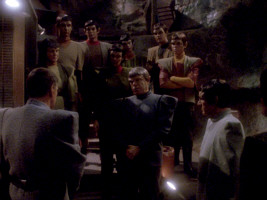
 Romulans in TNG: "Unification II"
Romulans in TNG: "Unification II"
